Fertilization
Download as pptx, pdf7 likes288 views
fertilization only occur when oocyte and sperm are activated .what happens when an activated sperm is able to penetrate ovum membrane .blocking the entrance of other sperms has a specific mechanism explained in this power point
1 of 17
Downloaded 17 times
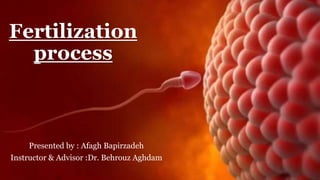
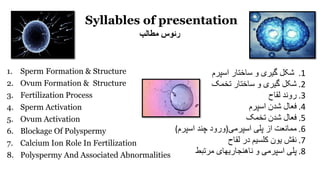
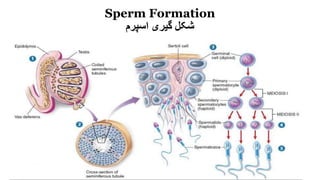
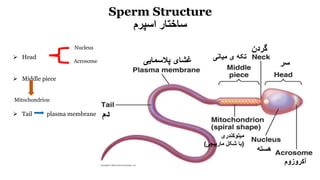

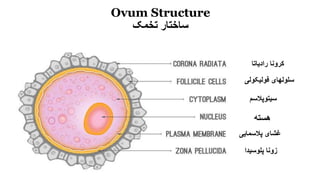
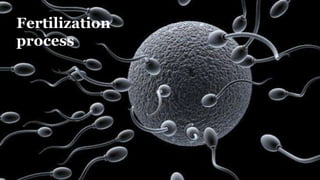
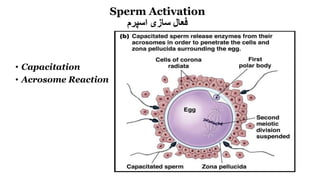

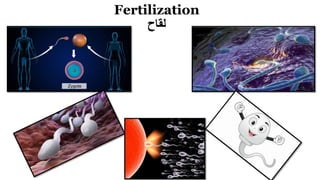
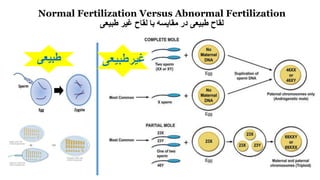

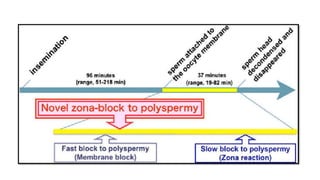


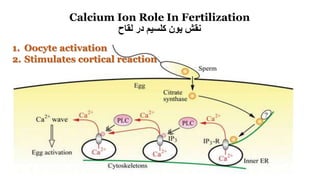
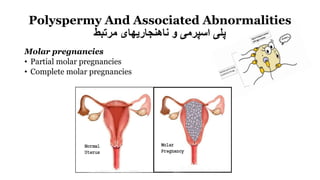
Ad
Recommended
Documentos primaria-sesiones-unidad02-integradas-sexto grado-sesion26-integ_6toTeresa Clotilde Ojeda Sánchez
╠²
Los niños revisarán y mejorarán el primer borrador de su proyecto de vida mediante el intercambio de trabajos con un compañero y la utilización de una ficha de revisión. Primero compararán su proyecto con la planificación inicial y luego identificarán errores para mejorarlo. Finalmente, escribirán la versión final de su proyecto de vida.Documentos primaria-sesiones-unidad06-cuarto grado-matematica-4g-u6-mat-sesion01Teresa Clotilde Ojeda Sánchez
╠²
Los estudiantes aprender├ín a elaborar encuestas para investigar los animales peruanos preferidos de sus compa├▒eros. Trabajar├ín en equipos para proponer preguntas de encuesta y decidir├ín cu├íl aplicar a la clase. Luego planificar├ín la recopilaci├│n de datos para conocer la opini├│n mayoritaria y elegir el animal a estudiar.Ó©ÜÓ©ùÓ©ùÓ©ÁÓ╣ê 4 Ó©½Ó©ÑÓ©▒Ó©üÓ©üÓ©▓Ó©úÓ╣üÓ©ÑÓ©░Ó©ºÓ©┤Ó©ÿÓ©ÁÓ©üÓ©▓Ó©úÓ╣üÓ©üÓ╣ëÓ©øÓ©▒Ó©ìÓ©½Ó©▓Ó©öÓ╣ëÓ©ºÓ©óÓ╣ÇÓ©ùÓ©äÓ╣éÓ©ÖÓ╣éÓ©ÑÓ©óÓ©ÁÓ©¬Ó©▓Ó©úÓ©¬Ó©╚¿╣ÇÓ©ùÓ©¿ Ó©í.2
Ó©ÜÓ©ùÓ©ùÓ©ÁÓ╣ê 4 Ó©½Ó©ÑÓ©▒Ó©üÓ©üÓ©▓Ó©úÓ╣üÓ©ÑÓ©░Ó©ºÓ©┤Ó©ÿÓ©ÁÓ©üÓ©▓Ó©úÓ╣üÓ©üÓ╣ëÓ©øÓ©▒Ó©ìÓ©½Ó©▓Ó©öÓ╣ëÓ©ºÓ©óÓ╣ÇÓ©ùÓ©äÓ╣éÓ©ÖÓ╣éÓ©ÑÓ©óÓ©ÁÓ©¬Ó©▓Ó©úÓ©¬Ó©╚¿╣ÇÓ©ùÓ©¿ Ó©í.2Por Oraya
╠²
Ó©½Ó©ÑÓ©▒Ó©üÓ©üÓ©▓Ó©úÓ╣üÓ©ÑÓ©░Ó©ºÓ©┤Ó©ÿÓ©ÁÓ©üÓ©▓Ó©úÓ╣üÓ©üÓ╣ëÓ©øÓ©▒Ó©ìÓ©½Ó©▓Ó©öÓ╣ëÓ©ºÓ©óÓ╣ÇÓ©ùÓ©äÓ╣éÓ©ÖÓ╣éÓ©ÑÓ©óÓ©ÁÓ©¬Ó©▓Ó©úÓ©¬Ó©╚¿╣ÇÓ©ùÓ©¿Ó©üÓ©▓Ó©úÓ╣ÇÓ©éÓ©ÁÓ©óÓ©ÖÓ©úÓ©▓Ó©óÓ©çÓ©▓Ó©ÖÓ╣éÓ©äÓ©úÓ©çÓ©çÓ©▓Ó©╚¿©ºÓ©┤Ó©èÓ©▓Ó©äÓ©¡Ó©íÓ©×Ó©┤Ó©ºÓ╣ÇÓ©òÓ©¡Ó©úÓ╣îÓ©ÿÓ©©Ó©úÓ©üÓ©┤Ó©ê
Ó©üÓ©▓Ó©úÓ╣ÇÓ©éÓ©ÁÓ©óÓ©ÖÓ©úÓ©▓Ó©óÓ©çÓ©▓Ó©ÖÓ╣éÓ©äÓ©úÓ©çÓ©çÓ©▓Ó©╚¿©ºÓ©┤Ó©èÓ©▓Ó©äÓ©¡Ó©íÓ©×Ó©┤Ó©ºÓ╣ÇÓ©òÓ©¡Ó©úÓ╣îÓ©ÿÓ©©Ó©úÓ©üÓ©┤Ó©êthanapat yeekhaday
╠²
Ó©üÓ©▓Ó©úÓ╣ÇÓ©éÓ©ÁÓ©óÓ©ÖÓ©úÓ©▓Ó©óÓ©çÓ©▓Ó©ÖÓ╣éÓ©äÓ©úÓ©çÓ©çÓ©▓Ó©╚¿©ºÓ©┤Ó©èÓ©▓Ó©äÓ©¡Ó©íÓ©×Ó©┤Ó©ºÓ╣ÇÓ©òÓ©¡Ó©úÓ╣îÓ©ÿÓ©©Ó©úÓ©üÓ©┤Ó©ê1 the loai_ppthe_hien_bai_hat_3288
1 the loai_ppthe_hien_bai_hat_3288Thi├¬n ─Éã░ß╗Øng T├¼nh Y├¬u
╠²
T├ái liß╗çu cung cß║Ñp kiß║┐n thß╗®c v├á phã░ãíng ph├íp vß╗ü thß╗â loß║íi v├á c├ích thß╗â hiß╗çn b├ái h├ít d├ánh cho sinh vi├¬n ng├ánh sã░ phß║ím mß║ºm non, bao gß╗ôm c├íc kh├íi niß╗çm vß╗ü ├óm nhß║íc, h├¼nh thß╗®c v├á thß╗â loß║íi ├óm nhß║íc c┼®ng nhã░ kß╗╣ thuß║¡t ca h├ít. N├│ nhß║Ñn mß║ính tß║ºm quan trß╗ìng cß╗ºa ├óm nhß║íc trong ph├ít triß╗ân cß║úm x├║c con ngã░ß╗Øi v├á c├ích thß╗®c giß║úng dß║íy b├ái h├ít cho trß║╗ em. Ngo├ái ra, t├ái liß╗çu c┼®ng giß╗øi thiß╗çu mß╗Öt sß╗æ h├¼nh thß╗®c ├óm nhß║íc tß╗½ d├ón gian ─æß║┐n chuy├¬n nghiß╗çp, nhß║▒m hß╗ù trß╗ú gi├ío vi├¬n trong viß╗çc dß║íy hß╗ìc.first section basic genetics laboratory.pptx
first section basic genetics laboratory.pptxnational institute of genetics and biotechnology of Iran (NIGEB)
╠²
The document explains the importance of studying genetics, covering fundamental concepts such as genes, chromosomes, and the human genome. It details chromosome structures, types based on centromere positioning, and the genetic differences between sexes, including dosage compensation and Barr bodies. A brief laboratory procedure for observing Barr bodies using a cheek swab is also described.bioinformatics and artificial intelligence .pptx
bioinformatics and artificial intelligence .pptxnational institute of genetics and biotechnology of Iran (NIGEB)
╠²
The document discusses bioinformatics, which involves the development of software tools to analyze biological data and predict health-related processes. It covers applications in various life sciences fields, including genomics, proteomics, drug design, gene therapy, and forensic analysis. Bioinformatics integrates statistics, biology, and computer science, employing techniques like differential gene expression analysis and machine learning to enhance research and crop productivity.Ninth section of animals physiology.pptx
Ninth section of animals physiology.pptxnational institute of genetics and biotechnology of Iran (NIGEB)
╠²
The document outlines the preparation of sodium chloride solutions for testing red blood cell (RBC) damage, particularly in the spleen. It describes conditions such as hereditary spherocytosis, thalassemia, and iron deficiency as disorders related to RBCs and their production of hemoglobin and other compounds. Additionally, it explains the transformation of heme into porphyrin and bilirubin as they pass through the liver.the eighth section of animal physiology.pptx
the eighth section of animal physiology.pptxnational institute of genetics and biotechnology of Iran (NIGEB)
╠²
The document discusses the cell membrane's structure and differences between eukaryotes and prokaryotes, emphasizing its phospholipid bilayer composition and associated proteins. It lists diseases related to cell membrane dysfunction, such as cystic fibrosis and Liddle's syndrome. Additionally, it outlines experiments to assess cell membrane permeability using beetroot slices and various solutions, highlighting the effects of molecular weight and solubility on permeability.seventh section physiology laboratory.pptx
seventh section physiology laboratory.pptxnational institute of genetics and biotechnology of Iran (NIGEB)
╠²
The document discusses the physiology of animals with a focus on counting red blood cells using a CBC test. It outlines the significance of red blood cell counts in various medical conditions such as smoking, congenital heart disease, and anemia, among others. Additionally, it provides details on the components of the hymn solution and instructions for counting red blood cells with a Neubauer slide.resume,CV,cover letter,letter of interest.pptx
resume,CV,cover letter,letter of interest.pptxnational institute of genetics and biotechnology of Iran (NIGEB)
╠²
The workshop presented by Dr. Afagh Bapirzadeh focuses on the essential job application documents such as resumes, CVs, and cover letters, outlining their importance and the formats available, including chronological, functional, and hybrid styles. Key resume writing principles and tips for crafting effective letters of interest are discussed, highlighting the differences between resumes and CVs, especially in academic contexts. Resources and online tools for resume preparation are also provided, emphasizing the significance of these documents in conveying one's education and accomplishments to potential employers or academic institutions.fourth section laboratory physiology.pptx
fourth section laboratory physiology.pptxnational institute of genetics and biotechnology of Iran (NIGEB)
╠²
The document provides an overview of the urinary system, detailing components such as kidneys, ureters, bladder, and urethra, alongside their functions in urine production and fluid balance. It also outlines urine composition and types, as well as procedures for urine analysis, highlighting the importance of careful sample handling to avoid contamination. Various urine samples and analysis methods, including microscopic examination, are described to evaluate urine characteristics.sperm analysis course for biology students.pptx
sperm analysis course for biology students.pptxnational institute of genetics and biotechnology of Iran (NIGEB)
╠²
The document discusses the importance of understanding infertility, outlining its types and implications for family planning and emotional well-being. It details male infertility, its diagnosis, and the analysis of sperm quality and motility in a laboratory setting. Key methodologies for sperm sample evaluation and sperm morphology assessment are also provided.OFFICE LAW CONSTITUTIONAL LAW AND WHAT IS ABOUT IT.PPTX
OFFICE LAW CONSTITUTIONAL LAW AND WHAT IS ABOUT IT.PPTXnational institute of genetics and biotechnology of Iran (NIGEB)
╠²
Ï¡┘é┘ê┘é ϺϻϺÏ▒█î █î┌®█î ϺÏ▓ Ï¡┘é┘ê┘é Ï╣┘à┘ê┘à█î ϺÏ│Ϭ .ϿϺ ϬÏ│┘äÏÀ Ï¿┘ç ϬÏ╣ϺÏ▒█î┘ü ┘¥Ïº█î┘ç Ϻ█î Ϻ█î┘å Ï¡┘é┘ê┘é ┘éϺϻÏ▒█î┘à ┘àϿϺϡϽ█î ┌®┘ç Ï»Ï▒ Ïó┘å ┘àÏÀÏ▒Ï¡ ┘à█îÏ┤┘êÏ» Ï▒Ϻ ϺÏ▓ ┘à┘åÏ©Ï▒ ┘éϺ┘å┘ê┘å Ï¿Ï▒Ï▒Ï│█î ┌®┘å█î┘à .second section physiology laboratory.pptx
second section physiology laboratory.pptxnational institute of genetics and biotechnology of Iran (NIGEB)
╠²
The document discusses the clotting process, detailing the steps involved in hemostasis and the various factors and diseases related to blood clotting, such as hemophilia and thrombocytopenia. It also outlines blood typing systems, explaining the characteristics of the four blood groups (A, B, AB, O) and their Rh factors, along with the significance of crossmatching in blood transfusion. The blood typing process in medical labs is briefly described, emphasizing the use of blood drops and antisera to determine clumping.first section physiology laboratory.pptx
first section physiology laboratory.pptxnational institute of genetics and biotechnology of Iran (NIGEB)
╠²
The document outlines an animal physiology laboratory course focusing on blood physiology, including the study of blood components like red and white blood cells, and platelets. It explains methods of collecting biological samples for testing, including phlebotomy techniques and differentiates between serum and plasma. It also covers the analysis of blood smears for diagnosing diseases, detailing procedures for staining and observing blood cells.eighth section zoology laboratory guide.pptx
eighth section zoology laboratory guide.pptxnational institute of genetics and biotechnology of Iran (NIGEB)
╠²
The document is a zoology laboratory guide covering various dissection topics, including rat, fish, frog, and invertebrates like cnidarians. It highlights the main features and characteristics of these organisms, such as their reproductive methods, symmetry, and feeding mechanisms. Specific attention is given to hydra, obelia, and jellyfish, detailing their life cycles and significance in research.fourth section zoology laboratory guide.pptx
fourth section zoology laboratory guide.pptxnational institute of genetics and biotechnology of Iran (NIGEB)
╠²
The document is a zoology laboratory guide outlining key features and characteristics of various animal phyla, particularly focusing on sponges (Porifera). It describes the anatomy, symmetry, and types of sponge bodies, including asconoid, syconoid, and leuconoid structures. The guide also highlights specific sponge genera, their habitats, and structural components.the artificial intelligence impact on international trade and the necessity o...
the artificial intelligence impact on international trade and the necessity o...national institute of genetics and biotechnology of Iran (NIGEB)
╠²
The document discusses the impact of artificial intelligence (AI) on international trade and highlights the need for regulatory legislation, particularly in the context of Iranian legal laws. It explores the effects of AI on business operations, customer service, sales platforms, and the necessity for new legal frameworks, including the concept of a virtual lawyer. Key issues addressed include job displacement, regulatory challenges, and the importance of defining the legal status of AI transactions.third section zoology laboratory guide.pptx
third section zoology laboratory guide.pptxnational institute of genetics and biotechnology of Iran (NIGEB)
╠²
The document is a zoology laboratory guide by Dr. Afagh Bapirzadeh for the first semester of 1402, detailing dissection views of various organisms including rats, fish, frogs, and classifications within main kingdoms of life. It highlights specific microorganisms like Euglena, Ceratium, Peridinium, Diatoms, and Volvox, describing their characteristics and structures. Visual aids with real pictures are provided to supplement the information on these organisms.second section zoology laboratory guide.pptx
second section zoology laboratory guide.pptxnational institute of genetics and biotechnology of Iran (NIGEB)
╠²
The zoology laboratory guide by Dr. Afagh Bapirzadeh covers various types of dissections including rat, fish, frog, and mollusca, as well as the classification of living creatures within the main kingdoms of life. It discusses the cellular structures and features of eukaryotic and prokaryotic cells, focusing on ciliates like Paramecium and Stentor. Key characteristics such as cilia, contractile vacuoles, and nuclei types are explained in detail.COVID-19 vaccines details.pdf
COVID-19 vaccines details.pdfnational institute of genetics and biotechnology of Iran (NIGEB)
╠²
The document outlines the history and scientific realities of vaccination, starting from Edward Jenner's smallpox vaccine in 1798 to the recent development of COVID-19 vaccines. It discusses different types of vaccines, including conventional and mRNA vaccines, along with their methodologies, advantages, and challenges. It also details the history of coronaviruses, COVID-19 vaccine development, and the phases of human clinical trials.Afagh Bapirzadeh.pdf
Afagh Bapirzadeh.pdfnational institute of genetics and biotechnology of Iran (NIGEB)
╠²
The document discusses the role of nsp1, a protein associated with the SARS-CoV-2 virus, in inhibiting human 40S ribosomes, which is crucial for virus replication. It details interactions between nsp1 and ribosomal RNA, as well as specific ribosomal proteins, and provides comparative sequence alignments among various species. The findings highlight the significance of nsp1 in viral infection and its potential as a target for therapeutic interventions.Molecular mechanisms of cold adaptation in bacteria
Molecular mechanisms of cold adaptation in bacterianational institute of genetics and biotechnology of Iran (NIGEB)
╠²
The document discusses the molecular mechanisms by which bacteria adapt to cold environments, focusing on alterations in membrane fluidity and the role of cold-shock proteins. It details methods such as changing fatty acid composition and gene expression changes that enable bacteria to maintain essential functions under low temperatures. Additionally, it covers the involvement of specific proteins and helicases in transcription and translation adjustments during cold-shock conditions.Method of investigation
Method of investigationnational institute of genetics and biotechnology of Iran (NIGEB)
╠²
Iranian are pioneers of conducting research in natural sciences .in this power point i categorized different types of investigation and compared them.Advanced molecular genetics
Advanced molecular geneticsnational institute of genetics and biotechnology of Iran (NIGEB)
╠²
The document investigates the global regulatory mechanisms in bacteria, focusing on the pho and fur regulons, which control gene expression in response to environmental signals related to phosphorus and iron, respectively. The pho regulon is crucial for adaptation to phosphate scarcity, regulating genes for phosphate acquisition and storage, while the fur regulon maintains iron homeostasis and regulates genes involved in various metabolic processes. Additionally, the document discusses the implications of these regulons in bacterial virulence and survival strategies.Crispr
Crisprnational institute of genetics and biotechnology of Iran (NIGEB)
╠²
The document provides an overview of the CRISPR/Cas system, detailing its discovery, mechanisms, and various applications in gene editing. It classifies CRISPR systems into three main types and discusses their underlying biochemical activities as well as potential off-target effects and delivery methods. Additionally, it highlights advancements in gene editing efficiency, recent developments in anti-CRISPR systems, and the potential for CRISPR technology in addressing genetic diseases.More Related Content
More from national institute of genetics and biotechnology of Iran (NIGEB) (20)
Ninth section of animals physiology.pptx
Ninth section of animals physiology.pptxnational institute of genetics and biotechnology of Iran (NIGEB)
╠²
The document outlines the preparation of sodium chloride solutions for testing red blood cell (RBC) damage, particularly in the spleen. It describes conditions such as hereditary spherocytosis, thalassemia, and iron deficiency as disorders related to RBCs and their production of hemoglobin and other compounds. Additionally, it explains the transformation of heme into porphyrin and bilirubin as they pass through the liver.the eighth section of animal physiology.pptx
the eighth section of animal physiology.pptxnational institute of genetics and biotechnology of Iran (NIGEB)
╠²
The document discusses the cell membrane's structure and differences between eukaryotes and prokaryotes, emphasizing its phospholipid bilayer composition and associated proteins. It lists diseases related to cell membrane dysfunction, such as cystic fibrosis and Liddle's syndrome. Additionally, it outlines experiments to assess cell membrane permeability using beetroot slices and various solutions, highlighting the effects of molecular weight and solubility on permeability.seventh section physiology laboratory.pptx
seventh section physiology laboratory.pptxnational institute of genetics and biotechnology of Iran (NIGEB)
╠²
The document discusses the physiology of animals with a focus on counting red blood cells using a CBC test. It outlines the significance of red blood cell counts in various medical conditions such as smoking, congenital heart disease, and anemia, among others. Additionally, it provides details on the components of the hymn solution and instructions for counting red blood cells with a Neubauer slide.resume,CV,cover letter,letter of interest.pptx
resume,CV,cover letter,letter of interest.pptxnational institute of genetics and biotechnology of Iran (NIGEB)
╠²
The workshop presented by Dr. Afagh Bapirzadeh focuses on the essential job application documents such as resumes, CVs, and cover letters, outlining their importance and the formats available, including chronological, functional, and hybrid styles. Key resume writing principles and tips for crafting effective letters of interest are discussed, highlighting the differences between resumes and CVs, especially in academic contexts. Resources and online tools for resume preparation are also provided, emphasizing the significance of these documents in conveying one's education and accomplishments to potential employers or academic institutions.fourth section laboratory physiology.pptx
fourth section laboratory physiology.pptxnational institute of genetics and biotechnology of Iran (NIGEB)
╠²
The document provides an overview of the urinary system, detailing components such as kidneys, ureters, bladder, and urethra, alongside their functions in urine production and fluid balance. It also outlines urine composition and types, as well as procedures for urine analysis, highlighting the importance of careful sample handling to avoid contamination. Various urine samples and analysis methods, including microscopic examination, are described to evaluate urine characteristics.sperm analysis course for biology students.pptx
sperm analysis course for biology students.pptxnational institute of genetics and biotechnology of Iran (NIGEB)
╠²
The document discusses the importance of understanding infertility, outlining its types and implications for family planning and emotional well-being. It details male infertility, its diagnosis, and the analysis of sperm quality and motility in a laboratory setting. Key methodologies for sperm sample evaluation and sperm morphology assessment are also provided.OFFICE LAW CONSTITUTIONAL LAW AND WHAT IS ABOUT IT.PPTX
OFFICE LAW CONSTITUTIONAL LAW AND WHAT IS ABOUT IT.PPTXnational institute of genetics and biotechnology of Iran (NIGEB)
╠²
Ï¡┘é┘ê┘é ϺϻϺÏ▒█î █î┌®█î ϺÏ▓ Ï¡┘é┘ê┘é Ï╣┘à┘ê┘à█î ϺÏ│Ϭ .ϿϺ ϬÏ│┘äÏÀ Ï¿┘ç ϬÏ╣ϺÏ▒█î┘ü ┘¥Ïº█î┘ç Ϻ█î Ϻ█î┘å Ï¡┘é┘ê┘é ┘éϺϻÏ▒█î┘à ┘àϿϺϡϽ█î ┌®┘ç Ï»Ï▒ Ïó┘å ┘àÏÀÏ▒Ï¡ ┘à█îÏ┤┘êÏ» Ï▒Ϻ ϺÏ▓ ┘à┘åÏ©Ï▒ ┘éϺ┘å┘ê┘å Ï¿Ï▒Ï▒Ï│█î ┌®┘å█î┘à .second section physiology laboratory.pptx
second section physiology laboratory.pptxnational institute of genetics and biotechnology of Iran (NIGEB)
╠²
The document discusses the clotting process, detailing the steps involved in hemostasis and the various factors and diseases related to blood clotting, such as hemophilia and thrombocytopenia. It also outlines blood typing systems, explaining the characteristics of the four blood groups (A, B, AB, O) and their Rh factors, along with the significance of crossmatching in blood transfusion. The blood typing process in medical labs is briefly described, emphasizing the use of blood drops and antisera to determine clumping.first section physiology laboratory.pptx
first section physiology laboratory.pptxnational institute of genetics and biotechnology of Iran (NIGEB)
╠²
The document outlines an animal physiology laboratory course focusing on blood physiology, including the study of blood components like red and white blood cells, and platelets. It explains methods of collecting biological samples for testing, including phlebotomy techniques and differentiates between serum and plasma. It also covers the analysis of blood smears for diagnosing diseases, detailing procedures for staining and observing blood cells.eighth section zoology laboratory guide.pptx
eighth section zoology laboratory guide.pptxnational institute of genetics and biotechnology of Iran (NIGEB)
╠²
The document is a zoology laboratory guide covering various dissection topics, including rat, fish, frog, and invertebrates like cnidarians. It highlights the main features and characteristics of these organisms, such as their reproductive methods, symmetry, and feeding mechanisms. Specific attention is given to hydra, obelia, and jellyfish, detailing their life cycles and significance in research.fourth section zoology laboratory guide.pptx
fourth section zoology laboratory guide.pptxnational institute of genetics and biotechnology of Iran (NIGEB)
╠²
The document is a zoology laboratory guide outlining key features and characteristics of various animal phyla, particularly focusing on sponges (Porifera). It describes the anatomy, symmetry, and types of sponge bodies, including asconoid, syconoid, and leuconoid structures. The guide also highlights specific sponge genera, their habitats, and structural components.the artificial intelligence impact on international trade and the necessity o...
the artificial intelligence impact on international trade and the necessity o...national institute of genetics and biotechnology of Iran (NIGEB)
╠²
The document discusses the impact of artificial intelligence (AI) on international trade and highlights the need for regulatory legislation, particularly in the context of Iranian legal laws. It explores the effects of AI on business operations, customer service, sales platforms, and the necessity for new legal frameworks, including the concept of a virtual lawyer. Key issues addressed include job displacement, regulatory challenges, and the importance of defining the legal status of AI transactions.third section zoology laboratory guide.pptx
third section zoology laboratory guide.pptxnational institute of genetics and biotechnology of Iran (NIGEB)
╠²
The document is a zoology laboratory guide by Dr. Afagh Bapirzadeh for the first semester of 1402, detailing dissection views of various organisms including rats, fish, frogs, and classifications within main kingdoms of life. It highlights specific microorganisms like Euglena, Ceratium, Peridinium, Diatoms, and Volvox, describing their characteristics and structures. Visual aids with real pictures are provided to supplement the information on these organisms.second section zoology laboratory guide.pptx
second section zoology laboratory guide.pptxnational institute of genetics and biotechnology of Iran (NIGEB)
╠²
The zoology laboratory guide by Dr. Afagh Bapirzadeh covers various types of dissections including rat, fish, frog, and mollusca, as well as the classification of living creatures within the main kingdoms of life. It discusses the cellular structures and features of eukaryotic and prokaryotic cells, focusing on ciliates like Paramecium and Stentor. Key characteristics such as cilia, contractile vacuoles, and nuclei types are explained in detail.COVID-19 vaccines details.pdf
COVID-19 vaccines details.pdfnational institute of genetics and biotechnology of Iran (NIGEB)
╠²
The document outlines the history and scientific realities of vaccination, starting from Edward Jenner's smallpox vaccine in 1798 to the recent development of COVID-19 vaccines. It discusses different types of vaccines, including conventional and mRNA vaccines, along with their methodologies, advantages, and challenges. It also details the history of coronaviruses, COVID-19 vaccine development, and the phases of human clinical trials.Afagh Bapirzadeh.pdf
Afagh Bapirzadeh.pdfnational institute of genetics and biotechnology of Iran (NIGEB)
╠²
The document discusses the role of nsp1, a protein associated with the SARS-CoV-2 virus, in inhibiting human 40S ribosomes, which is crucial for virus replication. It details interactions between nsp1 and ribosomal RNA, as well as specific ribosomal proteins, and provides comparative sequence alignments among various species. The findings highlight the significance of nsp1 in viral infection and its potential as a target for therapeutic interventions.Molecular mechanisms of cold adaptation in bacteria
Molecular mechanisms of cold adaptation in bacterianational institute of genetics and biotechnology of Iran (NIGEB)
╠²
The document discusses the molecular mechanisms by which bacteria adapt to cold environments, focusing on alterations in membrane fluidity and the role of cold-shock proteins. It details methods such as changing fatty acid composition and gene expression changes that enable bacteria to maintain essential functions under low temperatures. Additionally, it covers the involvement of specific proteins and helicases in transcription and translation adjustments during cold-shock conditions.Method of investigation
Method of investigationnational institute of genetics and biotechnology of Iran (NIGEB)
╠²
Iranian are pioneers of conducting research in natural sciences .in this power point i categorized different types of investigation and compared them.Advanced molecular genetics
Advanced molecular geneticsnational institute of genetics and biotechnology of Iran (NIGEB)
╠²
The document investigates the global regulatory mechanisms in bacteria, focusing on the pho and fur regulons, which control gene expression in response to environmental signals related to phosphorus and iron, respectively. The pho regulon is crucial for adaptation to phosphate scarcity, regulating genes for phosphate acquisition and storage, while the fur regulon maintains iron homeostasis and regulates genes involved in various metabolic processes. Additionally, the document discusses the implications of these regulons in bacterial virulence and survival strategies.Crispr
Crisprnational institute of genetics and biotechnology of Iran (NIGEB)
╠²
The document provides an overview of the CRISPR/Cas system, detailing its discovery, mechanisms, and various applications in gene editing. It classifies CRISPR systems into three main types and discusses their underlying biochemical activities as well as potential off-target effects and delivery methods. Additionally, it highlights advancements in gene editing efficiency, recent developments in anti-CRISPR systems, and the potential for CRISPR technology in addressing genetic diseases.Ninth section of animals physiology.pptx
Ninth section of animals physiology.pptxnational institute of genetics and biotechnology of Iran (NIGEB)
╠²
the eighth section of animal physiology.pptx
the eighth section of animal physiology.pptxnational institute of genetics and biotechnology of Iran (NIGEB)
╠²
seventh section physiology laboratory.pptx
seventh section physiology laboratory.pptxnational institute of genetics and biotechnology of Iran (NIGEB)
╠²
resume,CV,cover letter,letter of interest.pptx
resume,CV,cover letter,letter of interest.pptxnational institute of genetics and biotechnology of Iran (NIGEB)
╠²
fourth section laboratory physiology.pptx
fourth section laboratory physiology.pptxnational institute of genetics and biotechnology of Iran (NIGEB)
╠²
sperm analysis course for biology students.pptx
sperm analysis course for biology students.pptxnational institute of genetics and biotechnology of Iran (NIGEB)
╠²
OFFICE LAW CONSTITUTIONAL LAW AND WHAT IS ABOUT IT.PPTX
OFFICE LAW CONSTITUTIONAL LAW AND WHAT IS ABOUT IT.PPTXnational institute of genetics and biotechnology of Iran (NIGEB)
╠²
second section physiology laboratory.pptx
second section physiology laboratory.pptxnational institute of genetics and biotechnology of Iran (NIGEB)
╠²
first section physiology laboratory.pptx
first section physiology laboratory.pptxnational institute of genetics and biotechnology of Iran (NIGEB)
╠²
eighth section zoology laboratory guide.pptx
eighth section zoology laboratory guide.pptxnational institute of genetics and biotechnology of Iran (NIGEB)
╠²
fourth section zoology laboratory guide.pptx
fourth section zoology laboratory guide.pptxnational institute of genetics and biotechnology of Iran (NIGEB)
╠²
the artificial intelligence impact on international trade and the necessity o...
the artificial intelligence impact on international trade and the necessity o...national institute of genetics and biotechnology of Iran (NIGEB)
╠²
third section zoology laboratory guide.pptx
third section zoology laboratory guide.pptxnational institute of genetics and biotechnology of Iran (NIGEB)
╠²
second section zoology laboratory guide.pptx
second section zoology laboratory guide.pptxnational institute of genetics and biotechnology of Iran (NIGEB)
╠²
Molecular mechanisms of cold adaptation in bacteria
Molecular mechanisms of cold adaptation in bacterianational institute of genetics and biotechnology of Iran (NIGEB)
╠²
Fertilization
- 1. Fertilization process Presented by : Afagh Bapirzadeh Instructor & Advisor :Dr. Behrouz Aghdam
- 2. Syllables of presentation Ôǽ┘àÏÀϺ┘äÏ¿ÔǼ ÔǽÏ▒Ϫ┘êÏ│ÔǼ 1. Sperm Formation & Structure 2. Ovum Formation & Structure 3. Fertilization Process 4. Sperm Activation 5. Ovum Activation 6. Blockage Of Polyspermy 7. Calcium Ion Role In Fertilization 8. Polyspermy And Associated Abnormalities .1ÔǽϺÏ│┘¥Ï▒┘àÔǼ ÔǽÏ│ϺϫϬϺÏ▒ÔǼ Ôǽ┘êÔǼ Ôǽ┌»█îÏ▒█îÔǼ ÔǽÏ┤┌®┘äÔÂ─¼ .2ÔǽϬϫ┘à┌®ÔǼ ÔǽÏ│ϺϫϬϺÏ▒ÔǼ Ôǽ┘êÔǼ Ôǽ┌»█îÏ▒█îÔǼ ÔǽÏ┤┌®┘äÔÂ─¼ .3Ôǽ┘ä┘éϺϡÔǼ ÔǽÏ▒┘ê┘åÏ»ÔǼ .4ÔǽϺÏ│┘¥Ï▒┘àÔǼ ÔǽÏ┤Ï»┘åÔǼ Ôǽ┘üÏ╣Ϻ┘äÔǼ .5ÔǽϬϫ┘à┌®ÔǼ ÔǽÏ┤Ï»┘åÔǼ Ôǽ┘üÏ╣Ϻ┘äÔǼ .6ÔǽϺÏ│┘¥Ï▒┘à█îÔǼ Ôǽ┘¥┘ä█îÔǼ ÔǽϺÏ▓ÔǼ Ôǽ┘à┘àϺ┘åÏ╣ϬÔǼ)ÔǽϺÏ│┘¥Ï▒┘àÔǼ Ôǽ┌å┘åÏ»ÔǼ Ôǽ┘êÏ▒┘êÏ»ÔǼ( .7Ôǽ┘ä┘éϺϡÔǼ ÔǽϻÏ▒ÔǼ Ôǽ┌®┘äÏ│█î┘àÔǼ Ôǽ█î┘ê┘åÔǼ Ôǽ┘å┘éÏ┤ÔǼ .8Ôǽ┘àÏ▒ϬϿÏÀÔǼ Ôǽ┘åϺ┘ç┘åϼϺÏ▒█î┘çϺ█îÔǼ Ôǽ┘êÔǼ ÔǽϺÏ│┘¥Ï▒┘à█îÔǼ Ôǽ┘¥┘ä█îÔǼ
- 3. Sperm Formation ÔǽϺÏ│┘¥Ï▒┘àÔǼ Ôǽ┌»█îÏ▒█îÔǼ ÔǽÏ┤┌®┘äÔÂ─¼
- 4. Sperm Structure ÔǽϺÏ│┘¥Ï▒┘àÔǼ ÔǽÏ│ϺϫϬϺÏ▒ÔǼ Ôǽϻ┘àÔǼ Ôǽ┘¥Ïº┘äÏ│┘àϺ█î█îÔǼ ÔǽÏ║Ï┤Ϻ█îÔǼ Ôǽ┌»Ï▒Ï»┘åÔǼ ÔǽÏ│Ï▒ÔǼ Ôǽ┘à█îϺ┘å█îÔǼ Ôǽ█îÔǼ ÔǽϬ┌®┘çÔǼ Ôǽ┘çÏ│Ϭ┘çÔǼ ÔǽÏó┌®Ï▒┘êÏ▓┘ê┘àÔǼ Ôǽ┘à█îϬ┘ê┌®┘åÏ»Ï▒█îÔǼ (Ôǽ┘àϺÏ▒┘¥█î┌å█îÔǼ ÔǽÏ┤┌®┘äÔÂ─¼ ÔǽϿϺÔǼ) ´âÿ Head ´âÿ Middle piece Mitochondrion ´âÿ Tail plasma membrane Nucleus Acrosome
- 5. Ovum Formation ÔǽϬϫ┘à┌®ÔǼ Ôǽ┌»█îÏ▒█îÔǼ ÔǽÏ┤┌®┘äÔÂ─¼
- 6. Ovum Structure ÔǽϬϫ┘à┌®ÔǼ ÔǽÏ│ϺϫϬϺÏ▒ÔǼ Ôǽ┘¥┘ä┘êÏ│█îϻϺÔǼ ÔǽÏ▓┘ê┘åϺÔǼ Ôǽ┘¥Ïº┘äÏ│┘àϺ█î█îÔǼ ÔǽÏ║Ï┤Ϻ█îÔǼ Ôǽ┘çÏ│Ϭ┘çÔǼ ÔǽÏ│█îϬ┘ê┘¥Ïº┘äÏ│ÔǼÔǽ┘àÔǼ Ôǽ┘ü┘ê┘ä█î┌®┘ê┘ä█îÔǼ ÔǽÏ│┘ä┘ê┘ä┘çϺ█îÔǼ ÔǽÏ▒Ϻϻ█îϺϬϺÔǼ Ôǽ┌®Ï▒┘ê┘åϺÔǼ
- 8. Sperm Activation ÔǽϺÏ│┘¥Ï▒┘àÔǼ ÔǽÏ│ϺÏ▓█îÔǼ Ôǽ┘üÏ╣Ϻ┘äÔǼ ÔÇó Capacitation ÔÇó Acrosome Reaction
- 9. Oocyte Activation ÔǽϬϫ┘à┌®ÔǼ ÔǽÏ┤Ï»┘åÔǼ Ôǽ┘üÏ╣Ϻ┘äÔǼ 1. Cortical reaction to block against other sperm cells 2. Activation of egg metabolism 3. Reactivation of meiosis 4. DNA synthesis
- 11. Normal Fertilization Versus Abnormal Fertilization ÔǽÏÀÏ¿█îÏ╣█îÔǼ ÔǽÏ║█îÏ▒ÔǼ Ôǽ┘ä┘éϺϡÔǼ ÔǽϿϺÔǼ Ôǽ┘à┘éϺ█îÏ│┘çÔǼ ÔǽϻÏ▒ÔǼ ÔǽÏÀÏ¿█îÏ╣█îÔǼ Ôǽ┘ä┘éϺϡÔǼ ÔǽÏÀÏ¿█îÏ╣█îÔǼ
- 12. Polyspermy Blockage Mechanisms Ôǽ┘à┌®Ïº┘å█îÔǼÔǽÏ│ÔǼÔǽϺÏ│┘¥Ï▒┘à█îÔǼ Ôǽ┘¥┘ä█îÔǼ ÔǽϺÏ▓ÔǼ Ôǽ┘à┘àϺ┘åÏ╣ϬÔǼ Ôǽ┘çϺ█îÔǼ Ôǽ┘àÔǼ ´ü▒Slow Blockage Of Polyspermy (Ôǽ┌®┘åÏ»ÔǼ Ôǽ█îÔǼ ÔǽÏ┤█î┘ê┘çÔǼ ÔǽϿ┘çÔǼ ÔǽϺÏ│┘¥Ï▒┘à█îÔǼ Ôǽ┘¥┘ä█îÔǼ ÔǽϺÏ▓ÔǼ Ôǽ┘à┘àϺ┘åÏ╣ϬÔǼ) Involves zonal inhibiting proteins (ÔǽϿϺÏ┤Ï»ÔǼ Ôǽ┘à█îÔǼ ÔǽÏ▓┘ê┘åϺ┘äÔǼ Ôǽ█îÔǼ Ôǽϼ┘ä┘ê┌»█îÏ▒┘åÏ»┘çÔǼ Ôǽ┘çϺ█îÔǼ Ôǽ┘¥Ï▒┘êϬ█î█î┘åÔǼ ÔǽÏ┤Ϻ┘à┘äÔǼ) ´ü▒Fast Blockage Of Polyspermy (ÔǽÏ│Ï▒█îÏ╣ÔǼ Ôǽ█îÔǼ ÔǽÏ┤█î┘ê┘çÔǼ ÔǽϿ┘çÔǼ ÔǽϺÏ│┘¥Ï▒┘à█îÔǼ Ôǽ┘¥┘ä█îÔǼ ÔǽϺÏ▓ÔǼ Ôǽ┘à┘àϺ┘åÏ╣ϬÔǼ) Membrane depolarization (ÔǽÏ║Ï┤Ϻ█î█îÔǼ ÔǽÏ┤Ï»┘åÔǼ Ôǽϻ┘¥Ïº┘äÏ▒█îÏ▓┘çÔǼ)
- 14. Slow Blockage Of Polyspermy Ôǽ┌®┘åÏ»ÔǼ Ôǽ█îÔǼ ÔǽÏ┤█î┘ê┘çÔǼ ÔǽϿ┘çÔǼ ÔǽϺÏ│┘¥Ï▒┘à█îÔǼ Ôǽ┘¥┘ä█îÔǼ ÔǽϺÏ▓ÔǼ Ôǽ┘à┘àϺ┘åÏ╣ϬÔǼ
- 15. Fast Blockage Of Polyspermy ÔǽÏ│Ï▒█îÏ╣ÔǼ Ôǽ█îÔǼ ÔǽÏ┤█î┘ê┘çÔǼ ÔǽϿ┘çÔǼ ÔǽϺÏ│┘¥Ï▒┘à█îÔǼ Ôǽ┘¥┘ä█îÔǼ ÔǽϺÏ▓ÔǼ Ôǽ┘à┘àϺ┘åÏ╣ϬÔǼ ÔÇó Membrane Depolarization
- 16. Calcium Ion Role In Fertilization Ôǽ┘ä┘éϺϡÔǼ ÔǽϻÏ▒ÔǼ Ôǽ┌®┘äÏ│█î┘àÔǼ Ôǽ█î┘ê┘åÔǼ Ôǽ┘å┘éÏ┤ÔǼ 1. Oocyte activation 2. Stimulates cortical reaction
- 17. Polyspermy And Associated Abnormalities Ôǽ┘àÏ▒ϬϿÏÀÔǼ Ôǽ┘åϺ┘ç┘åϼϺÏ▒█î┘çϺ█îÔǼ Ôǽ┘êÔǼ ÔǽϺÏ│┘¥Ï▒┘à█îÔǼ Ôǽ┘¥┘ä█îÔǼ Molar pregnancies ÔÇó Partial molar pregnancies ÔÇó Complete molar pregnancies
